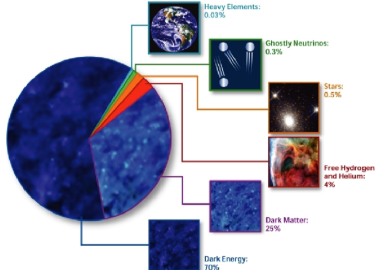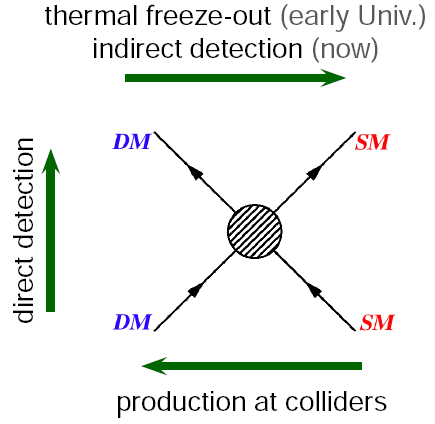Research: Dark Matter
The nature and origin of dark matter are two of the most exciting puzzles in high energy physics, cosmology, and astrophysics. Numerous astrophysical observation, for example, the motion of stars in galaxies or the distribution of the large-scale structure of the Universe, cannot be explained unless a non-luminous component of matter accounts for the bulk of the gravitating mass. This observation has been confirmed spectacularly by the observation of the Cosmic-Microwave-Background (CMB), i.e. the relic photons left over from the Big Bang, by the WMAP and Planck satellites. Today we know that roughly 80% of the matter in our Universe is made up by an unknown ”dark” kind of matter which does not emit light at any wavelength. The nature and origin of this dark matter is not understood and it constitutes one of the greatest challenges of modern physics. To crack this riddle physicists pursue different approaches which rely on methods from astrophysics, cosmology and particle physics. Members of the Max-Planck Institute for Nuclear Physics take part in the search for dark matter in theory and experiment.
Cosmological observations allow us to deduce certain basic properties of dark matter but they
do not allow us to identify the interactions of dark matter with the matter we know. There are
different hypotheses regarding the nature of dark matter which need to be investigated

Fig. 1: The composition of the known
Universe: shown are the contributions from Dark
Energy, Dark Matter and ordinary matter made of
Standard Model particles.
Thermal dark matter
One possibility which is predicted by many extensions of the Standard Model are particles with
weak-strength interactions with Standard Model particles. These scenarios generically predict a
dark matter abundance in the observed ballpark. This kind of dark matter particles is particularly
attractive since it predicts a number of complementary experimental signature which can be used
to search for dark matter
- The scattering of dark matter off regular matter. This process can be searched for with direct detection experiments such as LUX, XENON1T, DarkSide-50 or PandaX. These low background detectors aim to observe the recoil of a nucleus hit by a dark matter particle in deep-underground laboratories
- The annihilation of dark matter in the Universe today. This process produces highly energetic cosmic rays which can be searched for with gamma-ray telescopes, charged cosmic ray
detectors, or the neutrino telescope IceCube at the South Pole.
- The production of dark matter at Earth. High energy colliders, such as the Large Hadron
Collider (LHC) based at CERN allow creating conditions under which heavy particles can
be produced in the laboratory and the ATLAS, CMS, and LHCb experiments all search for
signs of dark matter in their data.
 Fig. 2: Interaction of thermal dark matter with
Standard Model particles.
Fig. 2: Interaction of thermal dark matter with
Standard Model particles.
In a given model the strength of the signals in these three observational channels (see
Fig. 2) are related and detailed theoretical predictions are required in order to exploit the full potential of the experimental search program. In addition, theoretical insight can reveal further signatures of dark matter and allows for the developments of new ways to test thermal dark matter. Even though this class of dark matter candidates is very appealing it is important to consider other dark matter candidates as well.
Non-thermal dark matter
One class of dark matter candidates with vastly different phenomenology is non-thermal dark
matter such as sterile neutrinos or FIMPs. These particles are only very weakly coupled to the
Standard Model and never reach thermal equilibrium in our Universe. They lead to quite distinct
signals such as:
Predicting these signatures is a non-trivial task which requires both a detailed understanding of
the dynamic of the early Universe and the experimental capabilities. The theory group at MPIK is
engaged in this field and contributes new predictions for the experimental signatures to the search
for dark matter. In addition, we are active in the search for new production mechanisms and investigate the correlations between astrophysical observations and laboratory searches.